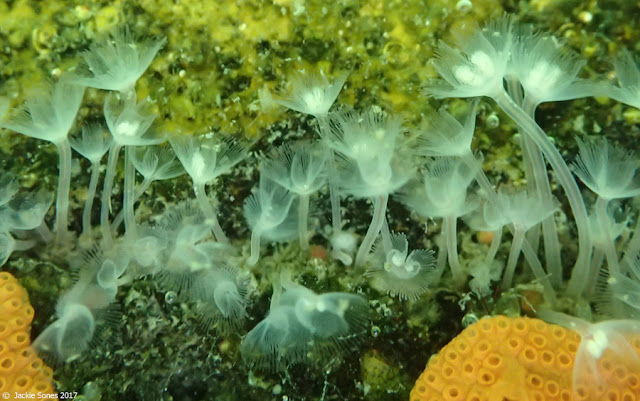Here's another highlight from that abandoned crab trap pulled up from about 3 miles offshore of Bodega Head on 7 September 2014. There was something slimy hanging from it, and if you know me, you know I couldn't resist looking at it. As I got closer, I heard a voice behind me say, "Yucky, Jackie, yucky!" It was said in a joking way...and you know it didn't stop me.
Well, I could tell that it was an egg mass, but I couldn't see very much while on the boat. And I knew that it was just going to dry up on deck. So I found a small plastic container in my backpack and brought it back to the lab.
The next day I looked at it under the microscope. The following series of images will let you see what I saw as I zoomed in to look more closely:
Pretty cool, right? Those are small packets of tiny embryos arranged like beads in long strings, all embedded in one large gelatinous mass.
On 8 September, the embryos were still fairly undeveloped (photos above), so it was hard to say what they might become.
But I decided to keep them around for a little while to see if they would develop further and provide hints about their identity. Just a few days later, on 11 September, they looked very different (next two photos):
Note that each larva has a red spot and two large transparent lobes. The lobes are called velar lobes and are lined with very active cilia. They help the larvae to swim and feed. At this stage the larvae are called veligers. And we can tell that they belong to a gastropod, although we're not sure which species. [See bottom of post for an update about the i.d.!]
These tiny gastropod larvae are much better appreciated in video format. This clip shows them actively swimming, first from a distance and then up close. Note their small shells, and if you look very carefully, you can occasionally see the long cilia beating along the edges of the velar lobes.
Mystery veligers from
Jackie Sones on
Vimeo.
ADDENDUM (12 September 2014): Jeff Goddard (master of all things related to marine invertebrates) has kindly solved this mystery. Here's what he says:
"Those are the
veligers of the side-gilled slug Pleurobranchaea californica. At
hatching they have a translucent red mantle organ located near the anus, a shell about 0.215 mm long, and a fairly large, powerful-looking
velum. Like other pleurobranchs, but unlike almost all other opisthobranchs, P.
californica veligers lack an operculum (the protective plate/trapdoor on
the back of the foot). This is because of their unique larval development,
during which the mantle quickly overgrows the shell, preventing withdrawal of
the body into the shell and rendering an operculum useless.
The slugs are large predators/scavengers found on sand or muddy bottoms and are
frequently attracted to the bait in crab pots. They lay delicate, curtain-like
egg ribbons containing strings of elongate egg capsules, each containing 20 to
25 embryos."




































